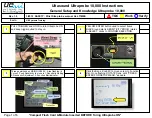
IM 11G06A01-02EN
2-5
2. SPECIFICATIONS
1st Edition : Oct. 27, 2023-00
Table 2.4
Sample gas conditions
Ambient temperature 10 to 50
°C
Ambient humidity
90
%RH or lower
Sample gas conditions Dust 2 µm or less in
particle size
NO
1000 ppm or less
SO
2
1000 ppm or less
SO
3
Unallowable
CO
500 ppm or less
CH
4
500 ppm or less
CO
2
15 vol% or lower
O
2
25 vol% or lower
No other corrosive gas
Built-in paramagnetic oxygen analyzer
Repeatability: ±0.5% F.S.
Linearity:
±1% F.S.
Zero drift:
±2% F.S./week
Span drift:
±2% F.S./week
Response time (90% F.S. response)
30 sec. or less
Sample gas conditions
Flow rate: 0.5 to 1.0 L/min
Temperature: 0 to 50°C
Pressure: 4.9 to 9.8 kPa (Gas outlet side should
be open to the atmospheric air. The
pressure fluctuation relative to the set
pressure shall be within ±2%.)
Dust:
2 µm or less in particle size
Mist:
Unallowable
Moisture: Below a level where saturation occurs at
5°C (No condensation)
No other corrosive gas
Reference gas conditions
Gas:
Atmosphere, instrument air or
N
2
Flow rate: 0.5 to 1.0 L/min
Temperature: 0 to 50°C
Pressure: 4.9 to 9.8 kPa (Gas outlet
side should be open to the
atmospheric air. The pressure
fluctuation relative to the set
pressure shall be within ±2%.)
Dust:
2 µm or less in particle size
Mist:
Unallowable
Moisture: Below a level where saturation
occurs at 5°C (No condensation)
Impurities other than CO
2
: 0.1% F.S. or
less of minimum measurement
range.
When the measurement range of the
CO
2
meter is C1, C2, C3, or C4, be
sure to use N
2
as the reference gas.
Standard gas for calibration
Zero gas: Dry N
2
Span gas: 80 - 90% concentration of the
range of each component to be
measured (recommended)
Concentrations above 105% F.S. are not
allowed.
Dry Air or Atmosphere can be used as the
span gas for the O
2
analyzer.
However, if a zirconia type O
2
analyzer
manufactured by YOKOGAWA is installed
externally and calibrated with the same calibration
gas line, use 1 to 2 vol% O
2
as
Zero gas.
Installation Requirements
• Indoor use: Avoid exposure to direct
sunlight, weather, and radiant heat from
hot substances. Where exposure to such
conditions is unavoidable, a protective
hood or cover should be prepared.
• Vibration-free environment
• A clean atmosphere
Summary of Contents for IR800G
Page 17: ...Blank Page...
Page 47: ...Blank Page...
Page 121: ...Blank Page...
Page 123: ......
Page 125: ......
Page 127: ...Blank Page...
















































